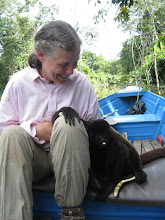My Muse wanes, but I will try to get it back.
As I continue the bus marathon to Chachapoyas I am glad
that this part of our trip is in daylight.
I have travelled this route before but only during the night and so have
not experienced the beauty of this slice of Peru.
Winding through the western portion of the
mountains I can see traces of habitation, mostly tidy squares of crops in a
multitude of green laying in eyebrow shaped bits of farmed land eked out along
the river bends at the base of the western mountains. Oranges, mangos and fields of rice are a stark
contrast to the dry mounds of mountainous rock.
Up, down and all around we go, as the road snakes and
switchbacks, a very long eventual east.
We pull over and stop briefly at a small pueblo for "passenger comfort". This is basically a poop stop, usually by
request. The on board toilet is for
"solo urinacion", something we are reminded of every few hours lest
the hold fill up with less desired secretions.
The mountains are still quite dry and barren, with
grasses and underbrush dotting their surface.
Then we reach that "sweet transformation" spot, when tropical
starts seeping into the air and vegetation.
This has been a bad year for rain, and the rockslides
that seem to come hand in hand with the weather. My choice of seating puts me near to the
upside of the mountain, which is all good until large chunks of rock start
falling in my direction. We have apparently
arrived at a trouble spot, and the bus slows to a crawl while making its' way
through the shower of rocks on the road.
I am not sure if the driver stops because he is unsure
about proceeding, (can't see how going back is even an option here) but I know
I feel uncomfortably like a sitting duck at this point. When the doors open and a group of young men
spring off to start picking up the rocks from the road I realize the driver is
also in a hurry to be away from the area.
Sure is beautiful though, the way the rocks glisten in
the rain. Whatever the geological term
for the formation, but the rocks sit like large irregular bricks piled in
layers for a long way up. Makes for tidy
squared rocks of all sizes falling easily.
Obviously we make it through the mountains because I sit
here writing about it.
The road continues to wind on through vegetation that is
now distinctly tropical. Broad leaves,
giant ferns and bamboo. Fields of farms
so waterlogged that workers pull their pant legs up as they walk, their lower
bodies soaked in mud.
At last we reach Bagua Grande for a quick stop to drop
off passengers. If possible the road
between Bagua and Pedro Ruiz is in even worse shape. The bus stops again, and this time it looks
like we are going to be a while. There
is no traffic coming towards us which is usually a bad sign no matter where in
the world you are. One of the drivers
gets out and walks ahead to investigate.
Now's the time to scratch your head and wonder just what
the criteria is that is used when deciding to try a crossing. It is a given that these drivers have a world
of experience sizing up the safety of a road.
The way that they have negotiated their way through the rock falls, streams
flowing over the road, and cracked asphalt are a testament to their judgment.
When the driver returns and we inch forward I figure no
problem, here we go. Well it turns out
that their has been a wash out , with most of the road missing. What is left is a mass of mud that has been
more or less "levelled" with a
small slice of navigable mud. The driver
opts to use this temporary passage to get this double decker, fully loaded bus
to the other side.
Nuts.
Terrifying.
The bus sinks into the mud despite having sped up to make
"a run for it". We continue
our forward motion even as the rear of the bus swings towards the river,
tilting the bus in the process. It was a
meet your maker kind of moment. Just
when I thought we were goners the front tires gained traction on the pavement
on the other side of the washout.
Like I said, a bad year for the roads.
We are hours behind schedule by the time we turn right
and head over the "Red Bridge" that signals the final leg of the
journey to Chachapoyas. The river is
raging as often happens during the rainy season. It takes about an hour of curvey roads and
then a long switchback climb to get us to the City.
I made it.
Twenty-four hours turned into twenty-eight.
But who is counting anymore... I am just relieved to have
made it at all.

No comments:
Post a Comment